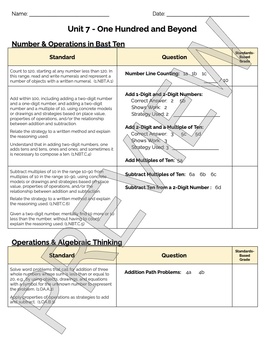Bridges 1st Grade Standards Based Post-Assessment Cover Sheet: Unit 7
Data Driven Design
1 Follower
Grade Levels
1st
Subjects
Resource Type
Standards
CCSS1.NBT.A.1
CCSS1.NBT.C.4
CCSS1.NBT.C.5
CCSS1.NBT.C.6
CCSS1.OA.A.2
Formats Included
- Google Docs™
Data Driven Design
1 Follower

Made for Google Drive™
This resource can be used by students on Google Drive or Google Classroom. To access this resource, you’ll need to allow TPT to add it to your Google Drive. See our FAQ and Privacy Policy for more information.
Also included in
- If you are working in a standards-based grading system, you might find it challenging to grade Bridges post-assessments using the MLC spreadsheets. Use these cover sheets to support your communication with parents/families in a standards-based format that also supports your standards-based grade booPrice $18.00Original Price $24.00Save $6.00
Description
If you are working in a standards-based grading system, you might find it challenging to grade Bridges post-assessments using the MLC spreadsheets. Use these cover sheets to support your communication with parents/families in a standards-based format that also supports your standards-based grade book.
You may also consider using these coversheets as tools for student reflection.
Suggested use:
- Complete a cover sheet for each student, circling the problem number(s) that are incorrect, allowing you to determine the standards-based grade within the rows of each domain.
- Staple the cover sheet onto the assessment for parents/students to better understand academic performance from a standards-based lens.
Total Pages
Answer Key
N/A
Teaching Duration
N/A
Last updated 3 months ago
Report this resource to TPT
Reported resources will be reviewed by our team. Report this resource to let us know if this resource violates TPT’s content guidelines.
Standards
to see state-specific standards (only available in the US).
CCSS1.NBT.A.1
Count to 120, starting at any number less than 120. In this range, read and write numerals and represent a number of objects with a written numeral.
CCSS1.NBT.C.4
Add within 100, including adding a two-digit number and a one-digit number, and adding a two-digit number and a multiple of 10, using concrete models or drawings and strategies based on place value, properties of operations, and/or the relationship between addition and subtraction; relate the strategy to a written method and explain the reasoning used. Understand that in adding two-digit numbers, one adds tens and tens, ones and ones; and sometimes it is necessary to compose a ten.
CCSS1.NBT.C.5
Given a two-digit number, mentally find 10 more or 10 less than the number, without having to count; explain the reasoning used.
CCSS1.NBT.C.6
Subtract multiples of 10 in the range 10-90 from multiples of 10 in the range 10-90 (positive or zero differences), using concrete models or drawings and strategies based on place value, properties of operations, and/or the relationship between addition and subtraction; relate the strategy to a written method and explain the reasoning used.
CCSS1.OA.A.2
Solve word problems that call for addition of three whole numbers whose sum is less than or equal to 20, e.g., by using objects, drawings, and equations with a symbol for the unknown number to represent the problem.



